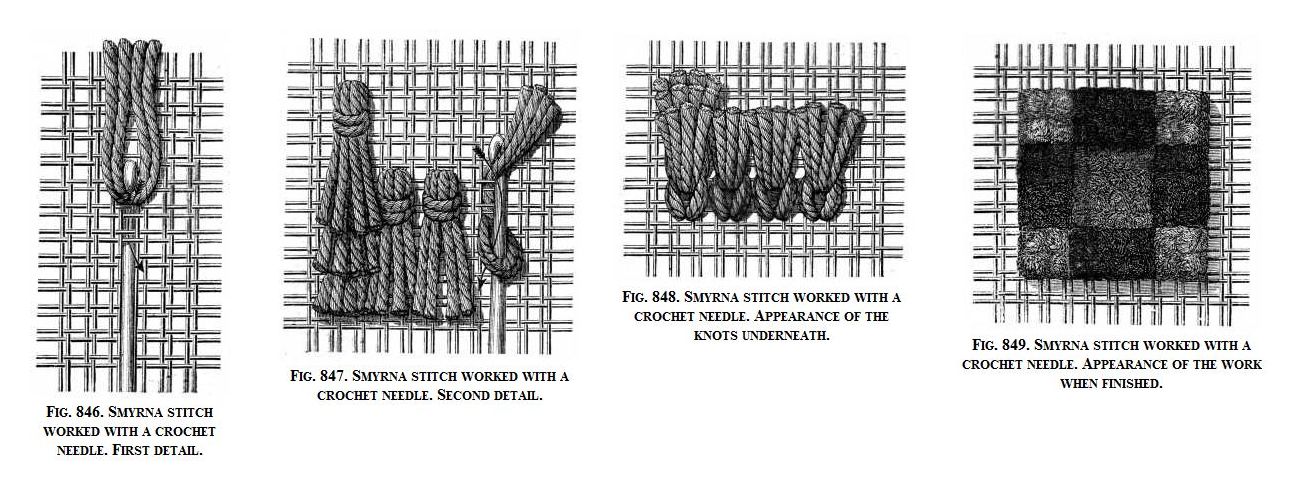
RUG-MAKING SUPPLIES - DMC (DOLLFUS MIEG ET COMPAGNIE)
DMC are well known today for their tapestry wool, but they also produced packs of pre-cut rug yarn. Their skeins of wool could be used as tapestry wool or, multi-stranded, as rug wool. Some of DMC yarns differ from other manufacturers in being flecked with darker shades of the main colour. This added a fine flecked effect, especially to background colours, on rugs worked in flecked yarn. Part of my Affy rug is worked in a DMC pre-cut yarn that is light brown flecked with white and mid brown, resulting in a natural stone appearance.
Dollfus Mieg et Compagnie (DMC) is an Alsatian textile company founded in Mulhouse in 1746 by Jean-Henri Dollfus, Jean-Jacques Schmalzwr and Samuel Koechlin. They began with a fabric printing business and, captialising on a fashion trend, were the first to manufacture hand painted Indian prints in Europe. Jean-Henri's nephew, Daniel took over from his uncle. Daniel married Anne-Marie Mieg in 1800 and the company became Dollfus-Mieg & Compagnie (DMC). They also owned the coal-mines that supplied all of their fuel, but later sold these due to poor performance (issues over fuel would resurface a century later). During the 19th century, DMC concentrated on cotton threads and embroidery thread.
At this time, they were working with designer Therese de Dillmont whose "Encyclopedia of Needlework" was published in 1884. Here's what Therese had to say on the subject of carpet-making:
"Smyrna stitch worked with a crochet-needle (figs. 846, 847, 848, 849).—In the chapter on tapestry, p. 137 we remarked that Oriental carpets and mats could be worked in different other ways, to be subsequently alluded to at greater length. Fig. 846. Smyrna stitch worked with a crochet needle. First detail. Fig. 847. Smyrna stitch worked with a crochet needle. Second detail. Smyrna stitch requires only a crochet needle and is worked on very coarse canvas or Java linen. You take a coarse mesh of cotton, such as Nos. 6, 8 or 10 of Colon à tricoter D.M.C (knitting cotton), cut it into lengths of 8 c/m., fold two lengths together in half, stick in the crochet needle from above, under two threads of the canvas, take hold of the loop with the hook, fig. 846, and draw it in; then push out the hook to seize the ends of the cotton and draw them through the loop which is on the needle, as indicated by the little arrow in fig. 847. The stitches or tassels should be two or three double threads of the canvas apart. As you finish each row, comb the ends of the tassels out carefully with a fine metal comb. When the whole piece of work is finished shear the entire surface, quite even, with a pair of sharp scissors. Fig. 849 shows a square of the work completed, presenting that warm velvety appearance which distinguishes the Smyrna carpets." (This was before the invention of the latch-hook)

During the 20th century DMC became one of the largest European industrial textile groups. In 1961, they merged with Thiriez & Cartier Bresson, retaining the trade name DMC and incorporating T&CB's horse's head motif into the logo in place of the bell formerly used. This is when DMC began diversifying into weaving and printed canvases. I bought their pre-cut Smyrna rug yarns during the 1980s. DMC hit a crisis in the 1990s with oil prices and with greater competition from Asia where wages (and hence prices) were lower. It tried to revive its flagging fortunes by expanding into interior design, but between 1998 and 2008 was forced to close several factories (e.g. its velvet concern) and reduce its workforce as sales continued to decline. The original DMC was liquidated in 2009 and its shares delisted. DMC was subsequently reincorporated and has refocussed on luxury textiles in the early twenty-first century. Today, DMC produce a wide range of needlework flosses and tapestry yarns, but no long produce rug yarn.
You are visitor number: